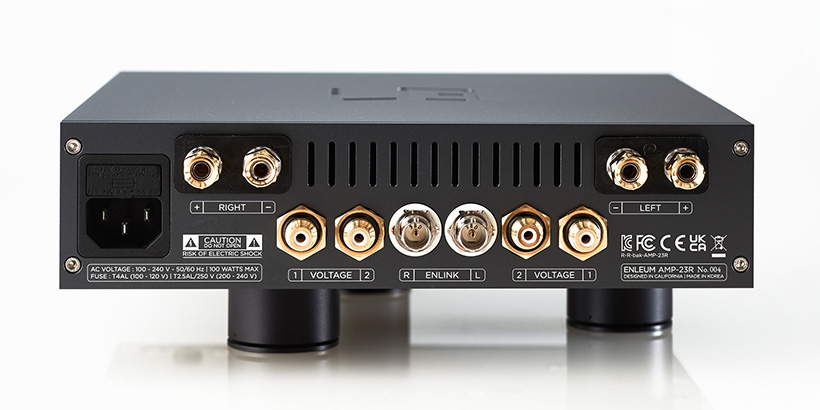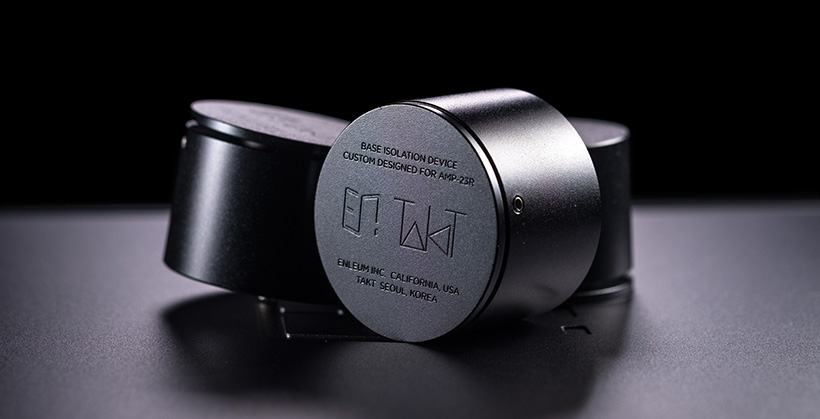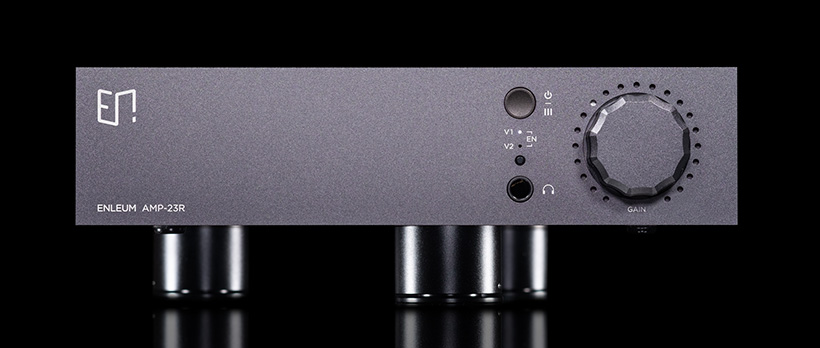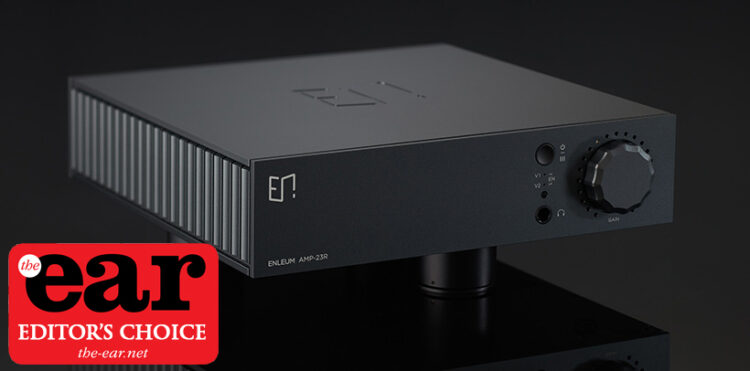As the audio world absorbs what former Bakoon International designer Soo In Chae has achieved with the AMP-23R integrated amplifier, the first product from his new Enleum brand, the aphorism that good things come in small packages might become rather over-used.
The AMP-23R is dinky. Coffee tables in the posher parts of west and north London are adorned with books much larger than this Korean-made amplifier. Priced at over five grand with optional isolation feet, it is hardly in bargain-basement territory, but neither can Enleum be accused of usury for asking such a sum for an integrated amplifier with the AMP-23R’s DNA and sonic abilities. Consider that it is also a head-fi amplifier with a performance that in some aspects challenges the best such dedicated devices and the AMP-23R begins to look like distinctly good value.
The Enleum AMP-23R is a zero-negative feedback Class AB design, using an enhanced version of the SATRI circuitry first used in Soo In Chae’s designs for Bakoon International. The proprietary Ensence input modules are constructed from discrete transistors and give a bandwidth of 10 Hz -1 MHz, although the whole amplifier is specified at a rather more modest 100 kHz. The input modules hand over via a relay-controlled precision attenuator to an output stage built around a pair of UK-made Exicon MOSFETs for each channel. The output employs a proprietary biasing arrangement that Soo In Chae has called JET2 – the figure two indicating that it is the second generation of this unusual circuit and JET because it is able to react with uncommon speed. It tracks the temperature of the output devices and makes biasing adjustments in virtual real-time. Bias current is converted from analogue to digital, compared against temperature and then increased or decreased by code on a micro controller chip before being converted back to analogue and applied to the output devices. The advantage, says Soo In Chae, is lower THD and more importantly that the bias current is always fixed and stable regardless of external changes, so that the transistors always run at their optimum.

The AMP-23R is surprisingly heavy at 4 kg, its chassis, machined and finished to a high standard that combines with a minimalist aesthetic that won it a Red Dot Design award. On the rear panel we find two pairs of gold-plated RCA inputs, plus a pair of BNC inputs supporting Enleum’s proprietary Enlink interconnect that will allow box-to-box chaining with future Enleum products. An auto-sensing IEC inlet and two pairs of gold plated binding posts complete the picture.
Heat dissipating radiators run the length of each side of the AMP-23R. On the front panel is the rotary gain control, the on/off button, pin-point LEDs that indicate which input is selected, the IR remote receiver and a ¼ inch headphone TRS socket. A tiny remote control allows the usual range of adjustments to be made, but in a sign that the design team is serious about the amplifier’s role as a head-fi device, also toggles output via the headphone jack between low and high.
Soo In Chae encourages us to think of the AMP-23R as a genuine dual-purpose amplifier able to drive both speakers and headphones. The headphone output is not handled by a separate add-on circuit but follows the same path as that for speakers, splitting just before the outputs into different relays, with a lower current one for the headphone socket to provide some protection for fragile devices. He says the AMP-23R will therefore drive “virtually anything from 4 Ohms to 600 Ohms or more. Its output impedance is about 0.8 Ohms and it outputs around 15 Watts into 14 Ohms and 4 Watts into 60 Ohms, decreasing linearly with higher impedances. The headphone output signal to noise is 96.6dB, the frequency response the same as the speaker output at 10 Hz to 100 kHz, and THD less than 0.1%.”

I tried the AMP-23R with 300 Ohm Sennheiser HD650 and 14 Ohm Audeze LCD-5 headphones. Informed students of the specifications in the preceding paragraph will not be surprised that the AMP-23R exhibited more than enough headroom for both headphones. In an exchange of email, Soo In Chae revealed that he too owns an Audeze LCD-5, but also a HiFiMan Susvara headphone. The latter a notorious black hole for energy, posing a particularly stiff test of any amplifier. He reports that the AMP-23R breezes the 83dB Susvara. I can quite believe it.
Sound quality
After a year or more during which many review amplifiers have come and gone from the household, all of them employing varying degrees of negative feedback and in two instances feed-forward, the AMP-23R came as a breath of fresh air. It was a reminder of the virtues of a simpler amplifier topology that as a deliberate choice does without the recursive, and some might observe corrosive impacts of feedback loops, in order to suppress THD. Yes. If we have been used to listening to amplification that drives THD way below the ability of human hearing, we can note that the output of the AMP-23R isn’t exactly the apogee of what’s possible in that department. And that might be all some buyers need to know. They will look at the figures and reflexively go elsewhere. But they will be missing out on a musical experience that in one particularly key way is perhaps closer-to-live than any box with stellar measurements can provide.

I offer no statistics to support this contention, but many people have zero experience of live acoustic music and are therefore ill-equipped to make an informed judgement of good versus bad audio. Before C-19, our monthly household spend on attending live symphonic concerts, folk and jazz recitals was substantial. Friends and associates would often be invited to join us. What interested me was how those guests unfamiliar with the experience would react. As audiophiles, readers of The Ear can surely agree that live music has four essential key qualities, even though we might argue over the names we give them. I call them dynamic expression/pressure, dynamic agility, tonal density/timbre, and timing. Readers might call them something else, but take a live music neophyte to a concert and with no prompting the first thing they notice is the dynamic expression; they feel it in their head, their chest. No matter whether it is a solo cello, a gut-strung guitar, a human voice or a symphony orchestra, it hits them like a hammer, particularly so if all they have heard previously is MP3 files.
Soo In Chae’s AMP-23R might, if pressed by measurists have cause to be apologetic about some of its test-bench stats when compared to some head-fi amplifiers, but the figures are a result of deliberate design choices, not happenstance or careless design. Despite those choices, or perhaps because of them, the AMP-23R does the head-and-chest-live-music-thing particularly well. Into headphones it delivers dynamics with speed, precision and power, and all the sweetness that we might hope for from a top-drawer low-output MOSFET design.

The Sennheiser HD650 and Audeze LCD-5 headphones, quite a way apart in their requirements of amplification, both responded to the AMP-23R in a way that made a compelling case for Soo In Chae’s approach. The AMP-23R is, as is sometimes the way with zero feedback designs, ultra-fast and also liquid and powerful – almost as if the dynamic expression is powered by a large rubber band that imbues the amplifier with large reserves of current but which doesn’t result in an unrealistically tight, buttoned-up sound. People either react positively to this style of presentation or not. As a consumer of as much live music as I can get, I make no apology for admitting that listening to the AMP-23R through either headphone was a fill-yer-boots opportunity for me. Pat Metheny’s style of jazz guitar triggers bafflement in some, yet the AMP-23R through my LCD-5 headphone gave his album One Quiet Night a reading that was utterly spellbinding. Recorded unaccompanied in his home studio, using a low tuned baritone guitar, the AMP-23R showcased Metheny’s almost preternatural sense of timing and tone, while delivering a real sense of being-thereness with a level of dynamic expression that through the LCD-5 and the HD650 generated real compression of the space between the ears. In a good way.
The AMP-23R dealt well with symphonic material too, confirming that it is a not a one-trick pony suitable for nothing more complex than solo guitar. I played the Hyperion recording of Mendelssohn’s violin concertos, the violinist Alina Ibragimova with the Orchestra of the Age of Enlightenment. Seen and heard live, Ibragimova is a virtual fireball of spiky energy, and more than most other amplifiers that I have used over the past year the AMP-23R transported me back to the last time I saw her, at The Anvil in Basingstoke. In the opening of the allegro of the Concerto in E minor the AMP-23R nailed the sweet and warm tone of the Anselmo Bellosio violin that Ibragimova plays and later, as the cadenza builds to a series of semiquavers, her satisfying resin bite and technical accuracy. Sound-staging through headphones, width and depth, was to a high standard, as we might hope and expect given the AMP-23R’s DNA.

If the little Enleum springs a surprise it is when it is asked to drive speakers and we find that 25 Watts per channel actually goes much further than some might expect. Readers who own efficient speakers might consider the AMP-23R as an alternative to tube amplification, and in that context I’d venture that its 25 Watts punch around the same as the output of a 211 amplifier with high quality output transformers and one VT4C tube per channel. Into the household (90dB at 8 Ohms) PMC MB2se speakers, the AMP-23R generated a more than satisfactory sound in our six by four metre room. With the volume control maxed out – and you wouldn’t want to do that to a 211 amp – the AMP-23R exhibited no signs of clipping or other audible distress. I measured SPLs of 79 dB with peaks of 87 or so. In fairness though, that’s almost certainly not the type of pairing or treatment that Soo In Chae had in mind.
Editor’s note
I also spent time with the Enleum amplifier and was definitely as charmed as Kevin. What struck me primarily was the speed and fluidity that he mentions, the AMP-23R has a triode like ability to deliver the immediacy of live music to an extent that’s rare in solid state designs. I tried a number of speakers including Bowers & Wilkins 802 D3 which are just too recalcitrant in the bass to be bossed by any 25 Watt design, but JBL HDI 3800s worked well and PMC twenty5.21s blew me away. This compact standmount is not very efficient at 86.5dB but it has an easy load and allowed the full expressiveness of this amplifier to shine through. Delivering superb imaging and remarkable bass alongside very high transparency. The Enleum may be smaller than a coffee table book but it is a heck of a fabulous amplifier in a rather stylish case.


